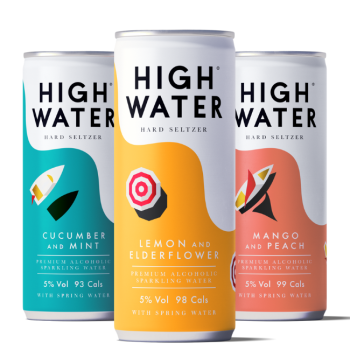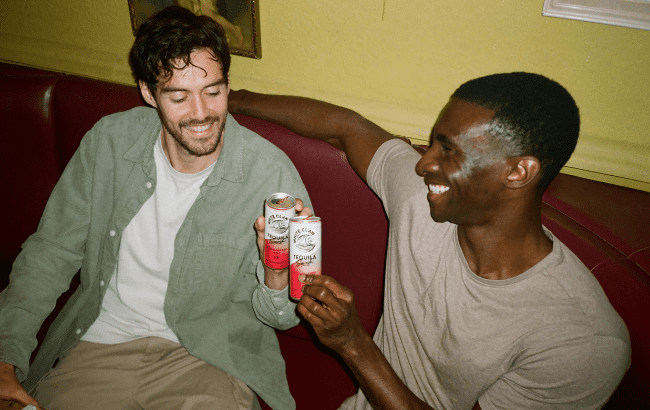Have hard seltzers gone soft?
By Lauren EadsFollowing a meteoric rise that proved to be short-lived, are hard seltzers in need of reinvention if the category is to remain relevant?

*This feature was originally published in the June 2025 issue of The Spirits Business magazine.
It’s no secret that hard seltzer has gone soft of late. After gaining mainstream popularity in the US in 2019, the trend found its way to the UK and spawned an entirely new category.
The hype was palpable – hard seltzer had arrived. But a few years later, in 2021, it hit its peak. Sales have since softened and growth is slowing or in decline, both in the US and UK. Is there longevity in the category, or is it a fad destined to fizzle out?
In 2021, one in three (33%) ready-to-drink (RTD) launches was a hard seltzer. This fell to one in nine (11%) in 2024 with flavoured alcoholic beverages (FABs) stealing share at their expense, says IWSR. FABs accounted for 28% of RTD launches in 2024, up from 16% in 2021.
RTD cocktails also gained, up from 38% in 2021 to 42% last year. While RTD cocktails and FABs are expected to rise at a compound annual growth rate (CAGR) of 4% and 3% respectively from 2023-2028, hard seltzers are expected to fall by 5%. This compares to the 2018-2023 period when hard seltzers grew at a CAGR of 48%.
Susie Goldspink, IWSR drinks industry analyst, says hard seltzer growth was mainly dominated by North America but it “failed to resonate with consumers elsewhere”, leading to a “big impact on growth projections”. She notes: “The slowdown post pandemic is partly driven to a shift back to on-premise where this format does not thrive. Secondly it has lost momentum in the US and Canada as the market was flooded with brands and flavours and the category lost its novelty with consumers. There is also more competition out there from other adult beverage categories and companies investing in beyond beer products.”
As a category that exploded so quickly, specifically in the US, some normalisation is to be expected. We are seeing larger brands fall from their peak, but the picture isn’t simply one of terminal decline – there’s plenty of optimism.
A report by Grand View Research in 2024 estimated the hard seltzer market would be worth US$60.16 billion by 2030, rising by a CAGR of 8.5% (2024-2030). A report published by Precedence Research in January 2025 stated that the global hard seltzer sector was worth US$19.03bn in 2024, and could reach US$74.93bn by 2034 – growing at a CAGR of 15% from 2025 to 2034.
White Claw, owned by Mark Anthony Brands, remains the biggest player with an estimated 58% share of the market, and continues to thrive in the US and UK. Nevertheless it has spread its bets with the launch of ClawTails canned cocktails this year, and a range of flavoured vodkas in 2024.
“While many brands exited the category, White Claw has maintained double-digit growth for four consecutive years,” says Michael Dean, UK marketing director at White Claw. “But as the category matures, the challenge isn’t survival, it’s relevance. We need to stay culturally front-footed while evolving what the category stands for.”
The biggest barriers for hard seltzer, says Dean, are availability and visibility. “In many retailers, RTD still suffers from limited space and without proper structure or signposting, making it tricky to recruit new shoppers and drive impulse purchases.”

The Boston Beer Co, which owns Truly, the second biggest hard seltzer brand, is less upbeat about its performance. CEO Michael Spillane acknowledged that the hard seltzer category “continues to decline with category sales down 5% in the first quarter dollar sales in measured off-premise channels,” in an April 2025 earnings call. He told investors he was “not satisfied” with Truly’s performance and outlined a marketing strategy to “reposition the brand to be more culturally relevant and improve volume trends over time”.
But while the growth of the RTD category “is normalising” in the US, there is still an “enormous opportunity for growth”, believes Britt West, chief commercial officer of Gallo wine and spirits, which owns spirit-based hard seltzer brand High Noon.
The biggest challenge, he says, is overcoming misconceptions about RTDs, specifically the quality of ingredients used, and market access. “There are still many markets where RTDs of similar ABV are discriminated against based on their base alcohol type,” he says. “Consumers have clearly spoken in favour of RTDs and it is a shame that certain markets block consumer access.”
There are challenges, certainly, but the US hard seltzer category is evolving, not disappearing. Is there demand for hard seltzer in the UK? Competition for market share is fierce, dominated by a handful of players, but challenger brands continue to enter the category.

High Water was founded in 2022 by ex-Diageo marketing manager and head of whisky innovation for Europe, Nick Britton. “From a High Water perspective we are seeing the category as a high-growth category across multiple markets, proving there is consumer appeal when the right product offering is made available,” he says.
High Water is based in the UK but has made significant moves in Dubai and the wider UAE, as well as Ibiza. “Being in the right places at the right times that are relevant for our customer is a key part of our strategy,” he adds. “Being the leading hard seltzer of Dubai and Ibiza helps to drive sales in the UK from great experiences people have whilst on holiday.”
Britton says hard seltzers suffered in the UK due to the on-trade being shut over Covid, with a “lack of transatlantic travel seeding the trend”, and the off-trade focusing on core products as opposed to innovation. “With all of these factors no longer inhibiting trial we are seeing growth in all channels,” he says.
Sales shrinking
In the UK off-trade, hard seltzer sales are still shrinking, with volumes down by 1.1% in the 52 weeks to 19 April 2025, but are falling less sharply than the previous two years, which saw volumes declines of 5.8% and 7.8% respectively, according to Circana data.
There’s still a market for hard seltzer, says Alex Lawrence, senior strategic insight director at Circana. “Seltzers and coolers are a small player within RTD but the volume performance in the last year indicates there is a core of seltzers and coolers for consumers which continue to enjoy these products and that the category is likely here to stay, albeit as a small player.”

For others, the domination of the category by big brands in the on-trade has made it impossible to compete. Long Shot Drinks, based in Herefordshire, launched its ‘all-natural’ hard seltzers in 2019, but after five years its founder, Hugo Hodgson, announced this month that it would be wrapping up. One factor in its demise, he says, was the grip White Claw has on venue contracts. By the end, a good deal for Hodgson was simply breaking even.
“It’s bittersweet,” he says. “We’ve tried across a number of number of different areas, and I just think the wider economic outlook just doesn’t look great,” he says. “Equally, it’s quite hard to penetrate with White Claw, but we do see a future for hard seltzer [in the UK].”
For Hodgson, the best path forward for hard seltzer in the UK could be for it to disappear altogether and return reinvented, perhaps reframing the ‘hard seltzer’ label. In the US, the term makes sense, but it doesn’t carry the same understanding in the UK, he says.
White Claw’s UK marketing director agrees that ‘hard seltzer’ can be “difficult to decode” for Brits, but it is steadfast on its dominance of the market. “Just a few years ago there were over 50 brands fighting for space in the category,” says Dean. “Today, White Claw accounts for 93% of the MAT [moving annual total] value share, turning a once-crowded category into a one-brand race.”
Rethinking strategies
Clearly hard seltzer brands need to rethink their strategy if they are to remain competitive. What might that look like?
“While the overall category is not expected to return to growth, there are segments within it that are still having success, namely spirit-based hard seltzers, which are a contrast to the malt-based products which previously dominated the category,” says IWSR’s Goldspink. In 2021, 75% of hard seltzer launches had a malt base, dropping to 59% in 2024. Meanwhile, spirit-based hard seltzers’ share of innovations lifted from 22% to 40%.
“Innovation is critical to keeping RTD relevant and exciting,” adds Dean. “It currently represents nearly a third of category value, and flavour is the main driver for attracting new drinkers.”

White Claw’s latest launch, White Claw Tequila Smash, taps into the growth of Tequila. High Noon also launched a Tequila Seltzer, in 2023.
“The landscape for growth is still enormous – from innovation, like fuller-strength canned cocktails and unique flavours, to new formats such as tetra packaging,” adds High Noon’s West.
Truly is focusing on higher-strength hard seltzers, demonstrated by the launch of its 8% ABV Truly Unruly Lemonade last year. CEO Spillane describes high-ABV offerings as a “bright spot in the hard seltzer category”, with Truly Unruly expected to be a “key contributor in improving the trajectory of the Truly brand”.
It would be easy to dismiss hard seltzer as a trend that’s had its moment – one that played its part in reinvigorating the RTD category but was destined to fizzle out – but that’s not necessarily the case. It remains a billion-dollar market in the US with millions more invested in the UK and beyond. But if hard seltzer brands are to retain engagement, and remain competitive, a level of repositioning needs to take place.
The hard seltzer boom might be over, but its next chapter is just beginning.
Related news
High Noon hard seltzers are an easy fan favourite
